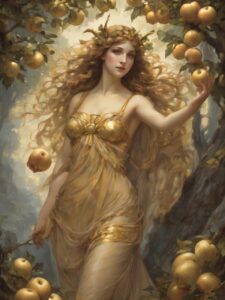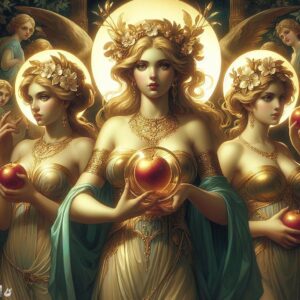Table of Contents
Brief overview of the Hesperides
The Hesperides, crucial in Greek mythology, are nymphs guarding the coveted golden apples. Born to Nyx or Atlas, their mythological origins intertwine with divine parentage. According to some accounts, they are daughters of Nyx, the embodiment of Night, while others attribute their parentage to Atlas, the Titan who holds up the sky. These nymphs hold a unique place in Greek mythology due to their role as the custodians of the mythical golden apples, a wedding gift to Hera. Their significance is deeply rooted in the tales of Heracles and his Twelve Labors.
Transitioning to the origins of the Hesperides, their parentage plays a crucial role in shaping their divine identity. Whether born from the personification of Night or the burdened Titan Atlas, the Hesperides embody the enchantment and mystery associated with the evening and the setting sun. This parentage connects them to elemental forces and cosmic symbolism, adding layers to their mythical existence. The dual parentage adds complexity to their character, emphasizing their link to both celestial and natural realms.
In various myths, the Hesperides are known for their beauty, grace, and association with the magical garden where the golden apples grow. Their story unfolds against the backdrop of divine lineage, celestial ties, and the allure of a sacred orchard. The Hesperides stand as ethereal figures, bridging the realms of gods and nature, their origins intertwined with the very fabric of Greek mythology.
Parentage of the Hesperides

The Hesperides trace their lineage to either Nyx, the embodiment of Night, or Atlas, the Titan. Born from Nyx, the Hesperides inherit the mystical essence of the night sky, shaping their divine character. Transitioning to the alternative lineage, their connection to Atlas, the Titan who bears the weight of the heavens, adds a terrestrial dimension to their celestial parentage.
These nymphs, named Aegle, Erytheia, and Hesperia, personify attributes associated with the evening and sunset. Aegle radiates with brightness, Erytheia embodies the red hues of sunset, and Hesperia, with a name derived from “hesperos” meaning evening, encapsulates the twilight’s essence. Their names and characteristics intertwine with the celestial canvas of the evening sky, mirroring the colors and radiance of the setting sun.
Transitioning to their collective role, the Hesperides are not mere bearers of names; they embody the very elements of dusk. The synergy of their individual attributes paints a vivid picture of the transition from day to night, capturing the magical and ephemeral beauty of twilight. This interplay of parentage, individual traits, and collective symbolism weaves a rich tapestry around the Hesperides, placing them at the nexus of celestial and terrestrial realms in Greek mythology.
Twilight Guardians: The Enchanting Names, Attributes, and Mythical Realm of the Hesperide
The Hesperides—Aegle, Erytheia, and Hesperia—personify qualities associated with evening and sunset, creating a celestial trio. Transitioning to their attributes, Aegle’s radiance, Erytheia’s sunset hues, and Hesperia’s name, derived from “hesperos,” encapsulate twilight’s essence. These names aren’t mere labels; they symbolize the colors and radiance of the setting sun.
Their roles intertwine with a sacred garden where golden apples flourish, a mythical orchard guarded by these celestial nymphs. Transitioning to the Garden of the Hesperides, it is a realm steeped in enchantment, representing the threshold between daylight and nightfall. This magical garden, often placed at the western edge of the world, embodies the transition from day to night.
Here, the golden apples, a divine gift to Hera, grow under the vigilant watch of the Hesperides. Their task of safeguarding these apples adds a layer of mystery to their roles. Transitioning to the symbolism of the garden, it becomes a metaphorical bridge connecting mortal realms with the divine, an ethereal space where the beauty of twilight is preserved.
This celestial trio, with names resonating with the hues of sunset, guards the mythical orchard in the Garden of the Hesperides, a testament to their vital roles in the tapestry of Greek mythology.
The Celestial Garden
The sacred garden, a mythical haven, blooms with ethereal beauty, a testament to celestial craftsmanship. Transitioning to its location, often placed at the western edge of the world, it symbolizes the meeting point between the mortal and divine realms.
Within this celestial oasis, golden apples flourish, bearing the essence of divine magic. Transitioning to the symbolism of these apples, they represent the ephemeral and coveted beauty of twilight. Guarded by the Hesperides, these apples symbolize the delicate balance between day and night.
Transitioning to the allure of the garden, it beckons as a sanctuary of enchantment, a tapestry woven with the hues of sunset. This mythical orchard, with its celestial patrons, becomes a living testament to the magic of twilight.
Harvest of Immortality: The Mythical Journey for the Golden Apples in Greek Legend
In Greek mythology, the golden apples trace their origin to the Hesperides, nymphs entrusted with guarding them. These apples, a divine gift from Gaia to Hera upon her marriage to Zeus, held immense significance.
Cunningly, Hera planted the sacred tree in her orchard at the edge of the world. Here, the Hesperides kept watch over the golden treasures. The apples, a symbol of immortality, bestowed everlasting youth upon those who consumed them.
Transitioning to the Labors of Heracles, one task involved stealing these coveted apples. Eurystheus commanded Heracles to fetch them, a feat deemed impossible. Yet, Heracles, driven by determination, embarked on a perilous journey.
Encountering numerous challenges, from the menacing Ladon serpent to Atlas holding the heavens, Heracles persevered. The golden apples, a reward for his tenacity, became a testament to his strength and resourcefulness.
Significantly, the Hesperides were associated with evening and sunset. As the sun dipped below the horizon, their presence signaled the onset of night. This transition mirrored the cyclical nature of life, embodying the beauty and inevitability of change.
In essence, the golden apples bridged the realms of gods and mortals, shaping the heroic narrative of Heracles. Their symbolism, intertwined with immortality and the passage of time, enriched the tapestry of Greek mythology.
Quest for the Hesperides: Unraveling the Geographical Enigma

Various interpretations exist regarding the location of the Hesperides’ garden. Some scholars suggest it resides in the Atlas Mountains. Others propose a connection to the Canary Islands. Despite these divergent views, historical and geographical references provide valuable context.
Ancient texts often mention a western location for the Hesperides’ abode. This aligns with the idea of a utopian paradise at the fringes of the known world. Notably, the Atlas Mountains in North Africa serve as a plausible candidate, given their prominence in Greek mythology.
Transitioning to geographical references, the Canary Islands emerge as a compelling contender. These islands, lying west of Africa, fit the description of a distant and mysterious realm. Some argue that the “Elysium Fields” mentioned by ancient poets could be synonymous with these Atlantic isles.
In conclusion, the exact location of the Hesperides’ garden remains a captivating enigma. While the Atlas Mountains and the Canary Islands present plausible candidates, the ambiguity persists. Historical and geographical clues offer glimpses into the ancient perspectives, yet the allure of the Hesperides’ elusive sanctuary endures.
FAQ
What is the significance of the golden apples?
The golden apples were a divine gift symbolizing immortality and eternal youth.
Where is the garden of the Hesperides located?
The exact location is a subject of debate, with theories suggesting the Atlas Mountains or the Canary Islands.
Why were the golden apples sought after?
The golden apples were one of the Labors of Heracles, representing a test of strength and determination.
How did the Hesperides relate to evening and sunset?
The Hesperides were associated with the evening and sunset, marking the transition from day to night.
What challenges did Heracles face in obtaining the golden apples?
Heracles faced obstacles such as the Ladon serpent and Atlas, who held the heavens.
Are the Hesperides mentioned in other mythological traditions?
The concept of nymphs guarding precious treasures appears in various cultures, but the Hesperides are distinct to Greek mythology.
What historical and geographical references are associated with the Hesperides?
The Atlas Mountains and the Canary Islands are often mentioned in connection with the possible location of the Hesperides' garden.
Do the golden apples have a broader symbolism in mythology?
Yes, the golden apples symbolize not only immortality but also the cyclical nature of life and the inevitability of change.
Why is the Hesperides' garden considered elusive?
The elusive nature of the garden is tied to the mythical and fantastical elements in Greek mythology, contributing to its enduring mystery.





